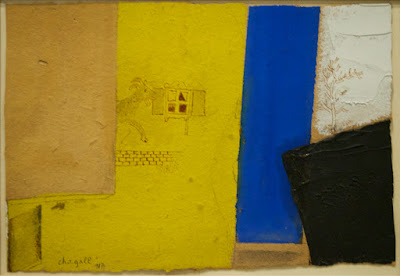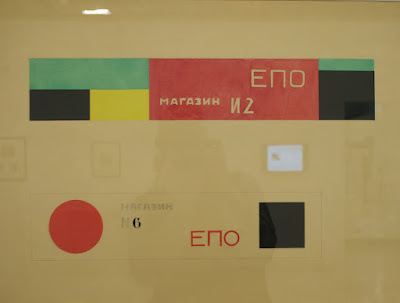John and I liked a fascinating show at the Centre Pompidou recently, Chagall, Lissistzky, Malévich, The Russian Avant-Garde in Vitebsk, 1918-1922.
In 1918 after the Russian Revolution, Marc Chagall was invited to found a new school of art --in true revolutionary spirit it was to be open to all for free. Portrait of Marc Chagall, 1914, by Iouri Pen.
This Self-portrait, 1918 by Chagall, shows the spirit of the new school. I like it - different from his more romantic work.
Chagall's, Study for the wall panel -- Introduction to the Kamerny State Jewish Theatre displays the cubist elements that had been influencing him in Paris. New visions for a New World.
as does his Cubist Landscape, 1919
and his Composition with a goat, 1917-1920 even hints at the Suprematist movement that would eventually overshadow the cubist influences at the school. Again nicely different from his usual work.
One of the first students at the school, Evgenia Magaril, painted this Composition in 1919-1920
Vassily Kandinsky painted this Moscow. La Place Zoubovski, circa 1916.
I liked Natalia Gontcharova's wonderfully lumpy The Wrestlers, 1909-1910.
El Lissitzky was invited to teach at the People's School of Art in 1919. Proun, circa 1922-1923 shows the growing abstract movement that would lead to the Suprematist style.
El Lissitsky was interested in combining painting and architecture -- witness his
Lenin Tribune, 1924
and his Prounenraum, 1920s, reconstructed here in 1971.
Stunning student work: Suprematist composition, 1920, by Ivan Koudriachov
and Nicolaï Souietine's, Composition, 1920.
Nicolaï Souietine, Sketches of signboards, 1921, in which the new Suprematist approach was taken into the streets of Vitebsk.
The major powerhouse of the Suprematist group was Kasimir Malevich (Mal-YAY-vitch). This is his Architectone, Gota, 1923
and Architectones and figurines, late 1920s. Beautiful designs for the practical world.
John particularly liked this Ration card of the Vitsvomas Commune, 1920 by Aleksandr Tsetline. The user's name would be entered in the lines on the large square and they would submit the 12 numbered tickets for daily food rations
until they were left with the major card and submit for a new set. Great design!
The Vitebsk Institute of Art disintegrated in 1923 as a result of economic conditions in post-Revolutionary Russia, but the experiment continues to inspire the world art community.
The Pompidou show makes a fascinating visit both for the works on display and the people watching. ____________________
Until July 16, 2018.





















OK who is the man in the white suit?
ReplyDeleteNo I did not know how to pronounce Malevich.
You two are a very good influence. Tickets to Paris are booked! Bring on the Proun!
BTW Shelly's sister and brother-in-law just tried the Moroccan place at the Marché des Enfants Rouges - without knowing of your recommendation. They loved it.
Have a great week!
LisaRR
We LOVE your comments, Lisa! Don't know who the white-suited man is - but he is definitely cool! Paris won't disappoint - glad you're booked.The Traiteur Marocain won't disappoint either. Check out La Maison des Tartes on Rue Moufftard as well - great deal for lunch!
ReplyDeletelove Bill